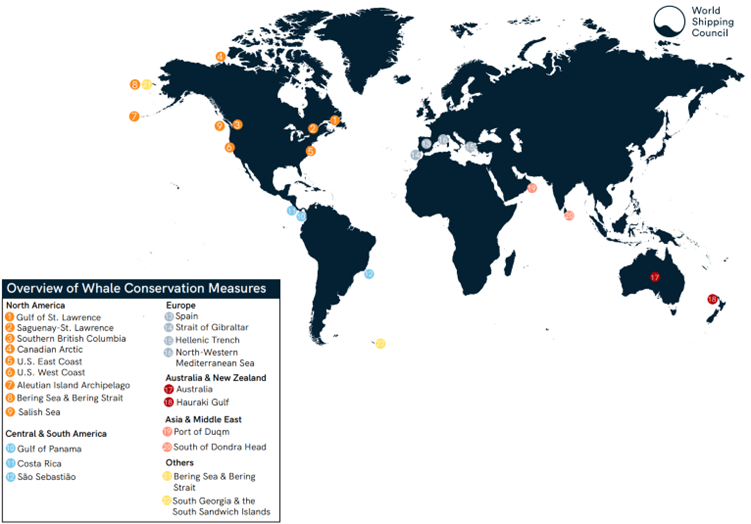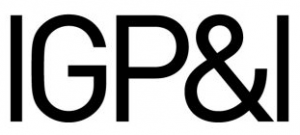Make sure that vessels’ voyage planning procedures take into account mandatory and voluntary speed restrictions meant to protect local whale populations and have a copy of the most recent WSC Whale Chart onboard.

Know when to slow down for whales
Published 27 November 2024
“Dear vessel owner, you have been caught speeding!”
Have you recently received a letter that begins like this:
Dear Vessel Owner.
The US National Oceanic and Atmospheric Administration's (NOAA) Office of Law Enforcement has information indicating that your vessel operated in excess of 10 knots inside an area to established to protect endangered North Atlantic right whales from collisions with vessels.
This letter is an official reminder of the Ship Strike Reduction Rule, found at 50 C.F.R. §224.105.
If so, you are not alone. Since 2018, NOAA has reportedly delivered around 2,000 similar letters to vessel owners that are alleged to be in violation of the 10-knot vessel speed rule that applies in designated Seasonal Management Areas (SMA) along the US East Coast. These SMAs are critical habitats for the endangered North Atlantic right whale and have speed restrictions in force from November to July each year to reduce the risk of collisions between vessels and whales (vessel strikes).
These NOAA letters, many of which contain no information about the actual alleged infringement, are part of an industry outreach program aimed at raising awareness about the US speed restriction scheme and to prevent future violations. If a fine is to be issued, the owner will likely receive a second notice explaining the specifics of the case and providing an opportunity to respond. The owner should therefore gather as much information as possible about the vessel's voyage, especially if weather, sea, or other navigational challenges at the time influenced the vessel's safe manoeuvring and therefore demanded a higher speed. If applicable, a corrective action plan or remedy to prevent future incidents should also be presented.
NOAA penalties can range from a few thousand to tens of thousands of dollars depending on the facts of the case and it is worth noting that, generally, fines for violating mandatory speed restrictions in whale sensitive areas is a risk not covered by P&I Rule 47.
Vessel speed restrictions are essential to protect whales
Many whale species are currently threatened by vessel traffic, particularly where their habitats and migration routes are close to major ports and overlap with shipping lanes. Although whales are large animals, they are not always clearly visible from the surface and can be difficult to spot by vessel crews. Even if the crew see the animal, there may not be enough time for either of them to avoid a collision if the vessel's speed is too high.
Quantifying and understanding the impact of vessel strikes can be challenging since these collisions frequently go undiscovered, unreported, or underreported. Since 2007, the International Whaling Commission (IWC) has attempted to develop a global database of vessel-whale collisions, but it acknowledges that its data is incomplete. According to experts cited by the World Sustainability Foundation, as many as 20,000 whales globally could be killed by vessels every year. However, even if not all vessel-whale collisions are fatal, also non-lethal contacts can cause animal misery. Internal injuries, deep propeller scars, and severed spines, tail flukes and fins, are just some of the injuries recorded in live and stranded animals that have been victims of collisions.
There is no universal solution to the problem of vessel strikes and the IWC states that, “for now, the most effective action to reduce collision risk is to keep whales and vessels apart and, where this is not possible, for vessels to slow down and keep a look out.” Numerous regional initiatives have already been launched to reduce vessel strikes: traffic separation schemes and routing measures, areas to be avoided, and speed restriction zones based on historical whale migration patterns and real-time animal sightings. Some initiatives are mandatory and legally enforceable while others are entirely voluntary. An interactive speed zone dashboard developed by the NOAA shows high overall vessel compliance with mandatory North Atlantic right whale vessel speed regulations. However, in locations where vessels are just encouraged to move slowly, or where dynamic measures change frequently, the compliance rates are likely to be lower.
Plan your voyages with whales in mind
Incident reporting and awareness of the risk of vessel strikes appear to be growing, but as vessel numbers and sizes increase, so does the potential for vessel-whale collisions. Furthermore, the risk may still be unknown to many seafarers.
The first challenge is simply learning where whales are. Enhancing awareness by highlighting areas with large whale populations and migration routes in the voyage planning is therefore important in order to reduce vessel strikes. The “WSC Whale Chart: A global voyage planning aid to protect whales” by the World Shipping Council (WSC) provides a comprehensive guide for the merchant shipping fleet to help protect whales from vessel strikes. It provides information on conservation measures, including mandatory and voluntary speed restrictions, areas to avoid, and routing measures. The chart also includes links to sources for dynamic measures that change frequently.
The measures are organized geographically and by jurisdiction and the whale regions to be aware of as of October 2024 are indicated in the map below.

According to the WSC, the chart will be updated annually, and it encourages readers to report any errors or updates.
Recommended precautions
We strongly recommend that a copy of the most recent edition of the WSC Whale Chart is available onboard at all times. Furthermore:
Make sure crews receive basic training in the precautionary measures to be taken when operating in areas where whales are known to be present, including identification and reporting. Learn more about the appearance and behaviour of whales from NOAA’s species directory.
Check for active speed restriction zones. Some authorities will activate temporary speed restriction zones at short notice if whales are confirmed to be in a certain location.
Encourage masters to reduce the vessel’s speed while transiting areas with voluntary speed restrictions and avoid areas with reported concentrations of whales. Navigate with caution and post lookouts that are familiar with spotting whales.
Collect information about whale sightings from all available sources. This enables crews to conduct the most prudent voyage planning to/from ports in areas where whales may be present. Different whale alert apps and online charts are also available.
Instruct crews not to intentionally approach whales as this maybe a violation of local law. Other vessels in the area should be alerted when a whale is sighted.
Provide a written report to the company as soon as possible following a whale strike, as well as to the local authorities of the event where applicable.
For vessels trading to the US, review, and update as necessary, vessels’ procedures for pre-arrival reporting to make sure they are in line with its Mandatory Ship Reporting System.
Useful sources and links
World Shipping Council: Protecting Whales
International Whaling Commission: Collisions between whales and vessels
The OCEAN Project: Best practices to avoid ship whale strikes (video)
US NOAA: Vessel strikes, including a Whale Alert App
Transport Canada: Protecting whales
Whale Safe: A technology-based mapping and analysis tool displaying whale and ship data for North America and the US West Coast
IMO MEPC.1/Circ.674: Guidance document for minimizing the risk of ship strikes with cetaceans


